Boulevard Adolphe Max
Boulevard Adolphe Max (French) or Adolphe Maxlaan (Dutch) is a central boulevard in Brussels, Belgium. It bears the name of a former mayor of the City of Brussels, Adolphe Max (1869–1939).
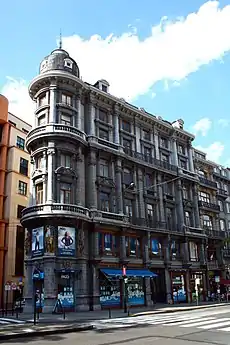 Narrow, triangle-shaped building on Boulevard Adolphe Max | |
 Location within Brussels | |
| Location | City of Brussels, Brussels-Capital Region, Belgium |
|---|---|
| Quarter | Marais–Jacqmain Quarter |
| Coordinates | 50°51′13″N 04°21′20″E |
| Construction | |
| Completion | 1867–1871 |
Boulevard Adolphe Max is located between De Brouckère Square and Charles Rogier Square, in the extension of Boulevard Anspach/Anspachlaan. The boulevard runs parallel to Brussels' busiest shopping street, Rue Neuve/Nieuwstraat. It is served by the metro and premetro (underground tram) stations De Brouckère and Rogier.
History
Boulevard Adolphe Max was built between 1867 and 1871, as part of the North–South Axis, which was created after the covering of the Senne. To stimulate the new boulevard's development, an architectural competition was organised. The first prize was awarded in 1876 to the Maison des Chats or Hier ist in den kater en de kat (loosely, "House of Cats") by architect Hendrik Beyaert.[1] The boulevard was originally named Boulevard du Nord/Noordlaan ("North Boulevard"), since it led to the old North Station on Charles Rogier Square. In 1919, it was renamed in honour of the then-mayor of the City of Brussels, Adolphe Max (1869–1939).

Until the Second World War, Boulevard Adolphe Max was one of the liveliest streets in Brussels, with renowned shops, typical Brussels cafés and an impressive number of cinemas. On 4 September 1944, it was the scene of great jubilation during the liberation of Brussels by the British Guards Armoured Division. From the 1970s however, the area entered a period of urban decay. Almost all the old shops disappeared, and in their place, souvenir shops, snack bars and sex shops opened. The luxurious Hotel Le Plaza, located on the boulevard, also closed its doors in 1976. Since 1976, the North–South line of the Brussels premetro has run underneath the boulevard. The reopening of Le Plaza in 1998 marked the beginning of a certain revival. By the turn of the 21st century, only a few sex cinemas remained. The last one, the ABC, closed in 2014.
In recent years, the introduction of one-way traffic on the side near De Brouckère Square has reduced the traffic volume considerably. There are also currently plans to renovate Boulevard Adolphe Max and its surrounding streets, as part of the broader revitalisation of the city centre.[2]
Notable buildings
- No. 1–3: Maison des Chats or Hier ist in den kater en de kat (1874) by Hendrik Beyaert[1]
- No. 5–9: Hotel Atlanta (1925–29) by Michel Polak[3]
- No. 11–17: Eclectic apartment building (1872) by F. Laureys[4]
- No. 118–126: Hotel Le Plaza (1928), Art Deco hotel and cinema by Alfred Hoch and Michel Polak[5]
- No. 104: Marivaux theatre, original neoclassical building (1873) by D.G. Marinus, Art Deco redesign (1923) by G. Hubrecht[6]
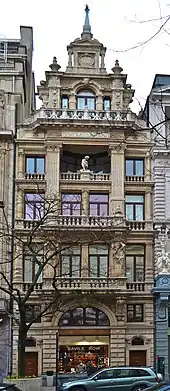
Maison des Chats or Hier ist in den kater en de kat, Beyaert (1874)  Hotel Atlanta, Polak (1925–29)
Hotel Atlanta, Polak (1925–29)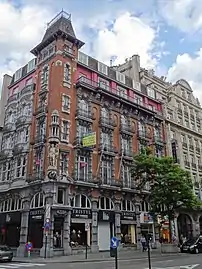
Apartment building, Laureys (1872) 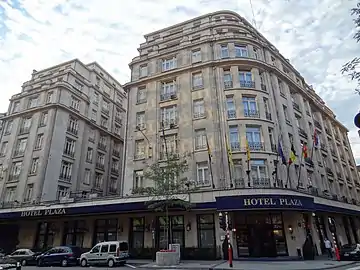
Hotel le Plaza, Hoch and Polak (1928) 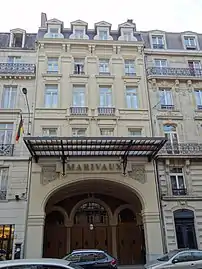
Marivaux theatre, Marinus (1873), Hubrecht (1923)
References
- "Bruxelles Pentagone - Hier is\'t in den Kater en de Kat - Boulevard Adolphe Max 1-3 - BEYAERT Henri". www.irismonument.be. Retrieved 2018-12-16.
- "Preliminary design for the reconstruction of the Boulevard Adolphe Max and surroundings". www.brussels.be. Retrieved 2018-12-16.
- "Hôtel Atlanta – Inventaire du patrimoine architectural". monument.heritage.brussels (in French). Retrieved 2021-01-26.
- "Bruxelles Pentagone - Boulevard Adolphe Max 11-13-15-17 - LAUREYS F." www.irismonument.be. Retrieved 2018-12-16.
- "Bruxelles Pentagone - Hotel Plaza - Boulevard Adolphe Max 118-126 - Rue de Malines 29-31 - Rue Saint-Pierre 37-39 - HOCH Alfred". www.irismonument.be. Retrieved 2018-12-16.
- "Bruxelles Pentagone - Theatre Marivaux (1922) / Marivaux (1967) - Boulevard Adolphe Max 104-106 - Rue Saint-Pierre 17-19-21-23-25 - MARINUS D.G." www.irismonument.be. Retrieved 2018-12-16.